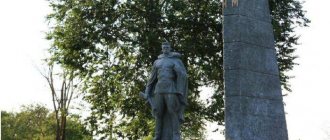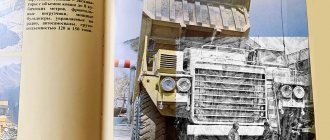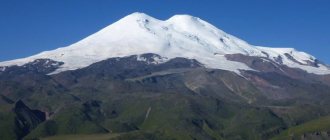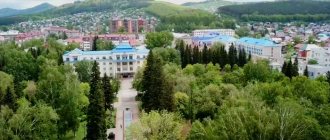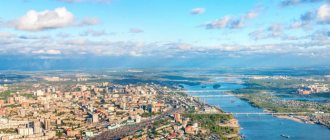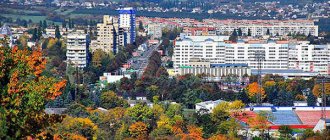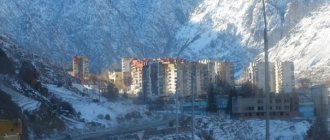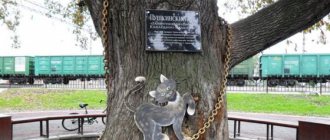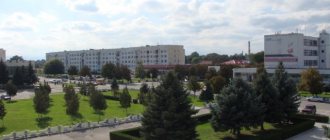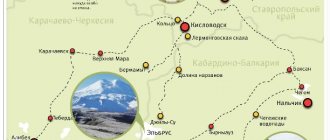Where is Kabardino-Balkaria located?
Located on the northern macroslope of the Greater Caucasus Range, the republic belongs to the North Caucasus Federal District and borders the Karachevo-Cherkess Republic, Stavropol Territory, North Ossetia and Georgia.
The modern borders of the republic were formed in accordance with the policy of national demarcation carried out in the early years of Soviet power. It is worth noting that the region where Kabardino-Balkaria is located is not very stable in national terms. This can be confirmed by the numerous national conflicts of the post-Soviet era.
In 1921, the Kabardian autonomy was formed, a year later it was transformed into the Kabardino-Balkarian autonomy, and in 1936 it became the Kabardino-Balkarian Autonomous SSR.
The history of the republic during the years of the USSR was not smooth, since the national issue was resolved by the authorities depending on the situation and in accordance with the ideas of the country's top leadership.
Content
- 1 Geography 1.1 Climate
- 1.2 Ecosystem
- 1.3 Rivers
- 1.4 Lakes
- 1.5 Waterfalls
- 1.6 Five-thousander peaks
- 4.1 Sex and age composition
- 7.1 Industry
History of Kabardino-Balkaria
There is a consensus among historians that the Kabardian subethnic group of the Adyghe people was artificially separated by the Soviet authorities into a separate people based on political considerations.
The USSR authorities were faced with the task of making national separatism on the outskirts the least numerous and as less aggressive as possible. For this purpose, the boundaries of national autonomies were drawn with the expectation that small national entities would not be able to resist the central government.
However, scientists believe that until the beginning of the twentieth century, Kabardins were just part of the Adyghe ethnic group, whose representatives lived on the eastern edge of the Adyghe habitat. It is worth noting: it is reliably known that modern Kabardians have been living in this territory since at least the 15th century, however, some information from historical and literary sources indicates that the ancestors of the people lived in the territory of Kabardino-Balkaria already in the 110th century.
Tourism
The city is a balneological and mountain climatic resort. About a quarter of the city is designated as a resort. In the resort part of the city and near it there are about 40 sanatoriums, holiday homes, tourist centers, and boarding houses. Balneological treatment procedures provided by sanatoriums can include baths both inside the sanatorium and in the city mud baths. The city has two amusement parks (in the resort area and in the Molodezhny microdistrict), four artificial lakes (filled during the swimming season from the Nalchik River), two cable cars (one of them has not been operational since 1993), mineral springs, a huge a park (one of the largest in Europe), turning into a forest, a health path, a zoo, a hippodrome. The picturesque mountains around are conducive to tourism, in particular, hiking and mountaineering. On Mount Malaya Kizilovka, opposite the resort part of the city, there is the Sosruko restaurant complex and observation platforms with an overview of the city, its near and far surroundings and mountain ranges.
Sanatorium and resort institutions in the city:
- Hydrotherapy
- Children's sanatorium "Zvezdochka"
- Children's sanatorium "Ogonyok"
- Children's sanatorium "Orlyonok"
- Children's social rehabilitation
- Boarding house "Dolinsk"
- Boarding house "Pear Grove"
- Sanatorium "Blue Spruce"
- Sanatorium "Mountain Spring"
- Sanatorium "Valley of Narzans"
- Sanatorium "Druzhba"
- Sanatorium named after Betal Kalmykov
- Sanatorium named after Sergei Kirov
- Sanatorium "Komsomolets"
- Sanatorium "Lebed"
- Sanatorium "Leningrad"
- Sanatorium "Mayak"
- Sanatorium "Moscow"
- Sanatorium "Narzan"
- Sanatorium "Olympus"
- Sanatorium "Terek"
- Sanatorium "Chaika"
- Sanatorium "Elbrus"
Balkars and the national question
Most scientists agree that the Balkars are the indigenous people of the Caucasus, since it is reliably known that the tribes on the basis of which this ethnic group was formed lived in the territory of what is now Kabardino-Balkaria since the 15th century AD.
However, some researchers are inclined to go even further in determining the duration of residence of the Balkars in the Caucasus, tracing their family back to the Koban archaeological culture.
However, modern Balkars are a Turkic-speaking people, the main ethnic element of which are the Turkic-speaking Bulgarians, who roamed the lands where the Republic of Kabardino-Balkaria is located in the 5th century AD.
The Mongol campaigns became a serious test for the Balkars, as a result of which Alania was defeated, and the Balkars were forced to rise from the plains to the mountains.
Settlements[ | ]
Main article: Settlements of Kabardino-Balkaria
Settlements with a population of more than 10 thousand people
Nalchik
| ↘239 054[24] | |
| Chill | ↗58 747[24] |
| Baksan | ↗38 645[24] |
| Nartkala | ↘30 464[24] |
| May | ↘26 318[24] |
| ↗20 661[24] | |
| Dygulybgey | ↗20 718[25] |
| Terek | ↗19 643[24] |
| Chegem | ↗18 542[24] |
| Nartan | ↗12 813[26] |
| ↗12 001[25] | |
| Zayukovo | ↗11 717[25] |
| Chegem Second | ↗11 575[25] |
| Naughty girl | ↗10 999[25] |
| Hasanya | ↗10 829[26] |
Post-war years of the 20th century
The region where Kabardino-Balkaria is located found itself in the zone of occupation by German troops during the Second World War. Most of the republic, including Nalchik, was under Nazi rule for almost two years.
After the liberation of the Caucasus by the Soviet authorities, mass repressions began in the region, to which not only large social groups, but also entire nations were subjected.
Chechens, Ingush, Crimean Tatars, Meskhetian Turks, Azerbaijanis, Armenians and Balkars were evicted to remote areas of the Soviet Union. The national autonomies of many deported peoples were liquidated, and the Kabardino-Balkarian Republic was transformed into the Kabardian Republic.
Population[ | ]
Main article: Population of Kabardino-Balkaria
The population of the republic, according to Rosstat, is 869,191[6] people (2021). Population density - 69.70 people/km² (2021). Urban population - 52.01[18]% (2020).
The mortality rate in 2016–2017 (as of the end of the year) was 8.5 ppm[19].
| People | Number of people in 2010, people[20] | Number of people in 2002, people[21] | Number in 1989, people[22] |
| Kabardians | ↘490 453 (57,2 %) | 498 702 (55,3 %) | 363 494 (48,2 %) |
| Russians | ↘193 155 (22,5 %) | 226 620 (25,1 %) | 240 750 (31,9 %) |
| Balkars | ↗108 577 (12,7 %) | 104 951 (11,6 %) | 70 793 (9,4 %) |
| Turks | ↗13 965 (1,6 %) | 8770 (1 %) | 4162 |
| Ossetians | ↘9129 (1,1 %) | 9845 (1,1 %) | 9996 (1,3 %) |
| Armenians | ↘5002 | 5342 | 3512 |
| Ukrainians | ↘4800 | 7592 | 12 826 (1,7 %) |
| Koreans | ↘4034 | 4722 | 4983 |
| Gypsies | ↗2874 | 2357 | 2442 |
| Circassians | ↗2475 | 725 | 614 |
| Tatars | ↘2375 | 2851 | 3005 |
| Azerbaijanis | ↘2063 | 2281 | 2024 |
| Chechens | ↘1965 | 4241 | 736 |
| Georgians | ↘1545 | 1731 | 2090 |
| Laktsy | ↘1462 | 1800 | 1587 |
| Germans | ↘1462 | 2525 | 8569 (1,1 %) |
| Ingush | ↗1271 | 1236 | 664 |
| Karachais | ↘1028 | 1273 | 1202 |
| Persons who did not state their nationality | ↗2269 | 15 | 0 |
Note: the table shows nations with a population of more than 1000 people in 2010. Note 2: many Kabardians, like other Circassians, indicated their exoethnonym - “Circassian” during the 2010 census.
Age and gender composition[ | ]
According to the 2010 All-Russian Population Census[23]:
| Age | Men, persons | Women, persons | Total number, people | Share of the total population, % |
| 0 – 14 years | 84 068 | 80 834 | 164 902 | 19,2 % |
| 15 – 59 years | 274 148 | 302 840 | 576 988 | 67,1 % |
| from 60 years old | 43 559 | 74 490 | 118 049 | 13,7 % |
| Total | 401 775 | 458 164 | 859 939 | 100,0 % |
Men - 401,775 people (46.7%). Women - 458,164 people (53.3%). The average age of the population is 35.3 years. The median age of the population is 32.8 years. The average age of men is 33.4 years. The median age of men is 30.8 years. The average age of women is 36.9 years. The median age of women is 34.9 years.
Modern republic
To answer the question “Kabardino-Balkaria - where is it?”, just look at the map of southern Russia. The republic is located in the central part of the North Caucasus, and its highest point is Mount Elbrus, which not only serves as a recognizable symbol of the republic, but also attracts numerous tourists who prefer active recreation.
Organized group ascents to Elbrus and alpine skiing are very popular among travelers, for which there are special trails on the mountain slopes.
In addition to tourism, agriculture is developed in the republic: both grain crops and industrial crops are grown. Wheat, corn and sunflower are grown in large quantities. Meat and dairy farming, including sheep breeding, is also developed.
More than two hundred industrial enterprises operate in the region where the Kabardino-Balkarian Republic is located. Photos of beautiful landscapes, found in large quantities on the Internet, are side by side with photographs of such large enterprises as the Baksan hydroelectric power station and Terekalmaz, which produces artificial diamonds.
In addition, the republic has developed the production of building materials, such as high-quality bricks, cement and metal products, as well as asphalt for road construction.
Geography
View of the main part of the city from above Geographical location
The mountains in Nalchik are very beautiful - covered with forests, they are green, curly, and in the fall they turn crimson, like fire.
— Ivan Vasilenko
The city is located in the central part of the republic, on both banks of the Nalchik river of the same name (Terek basin), at latitude 43°29′ and longitude 43°37′.
The area of the urban district is 131 km2, of which 67 km2 falls directly on the lands of the city of Nalchik.
The city is located in the foothills zone of the republic. It is surrounded from the south and west by one of the ridges of the Wooded Range. The ridge has a steep, almost vertical slope in the south and a flatter northern part, and in the form of a horseshoe surrounds the city of Nalchik on three sides. The outlines of the hills of the Lesysty Ridge are mostly soft and smooth. In the north, the Lesistoy ridge is adjacent to the southwestern tip of the Kabardian foothill plain with a sloping undulating topography. The average altitude on the city's lands is 512 meters above sea level. The highest point of the city is Mount Bolshaya Kizilovka (849 m), which drops to a minimum of 420 meters in the north of the city.
Hydrology
The river Nalchik of the same name flows through the lands of the city, as well as the rivers Shalushka (in the north-west of the city) and Sukhaya Shalushka (in the west of the city). Along the valley of the Nalchik River on the lands of the city park there are 4 lakes, the largest of which are the First Lake and the Fourth (Resort) Lake. To the south of the city there are several dammed lakes that are used to regulate the flow of the Nalchik River. Also on the city’s lands there are 18 mineral springs of various physical and chemical compositions. In general, the city's lands are highly supplied with water. Groundwater mainly lies at a depth of 3-5 meters.
Ecology
The ecological state of the resort city of Nalchik is generally stable. The only major polluting enterprise on the city's lands is OJSC Gidrometallurg, which produces tungsten anhydride and molybdenum concentrate. For several years now, the Ministry of Natural Resources and Ecology of the Republic has been demanding that the plant’s activities be suspended, but the trial continues.
Climate
The climate of the city is that of the foothills. The relative proximity of the Main Caucasian Range has a noticeable impact on the climate in the district's lands. Protection from the direct invasion of cold air plays a significant role in the development of climate. A characteristic feature is daily fluctuations in air temperature, especially observed mainly in the summer. These features are associated with local mountains and valley winds (mountain breezes). Average air temperatures range from +25°...+28° in July, to −3°...-5°C in January. The average annual air temperature is 8.6°C. The highest air temperatures are observed at the end of July, and the lowest at the end of January or early February. The average annual precipitation is about 600 mm. The relative humidity value is unstable. The average annual humidity is 78%, reaching a maximum of 85-86% in winter, and a minimum of 68-69% in summer. The predominant wind directions throughout the year are southwest, east and northeast.
Climate of Nalchik Indicator Jan. Feb. March Apr. May June July Aug Sep. Oct. Nov. Dec. Year Average maximum, °C 0 1 7 16 21 25 27 26 22 15 8 3 15 Average temperature, °C −3 −3 3 11 16 19 22 21 17 10 5 0 10 Average minimum, °C −7 −6 −1 5 11 14 17 16 12 5 1 −4 5 Precipitation rate, mm 22 23 38 63 99 43 29 26 631 Source: worldweather.org Time zone
Nalchik is located in a time zone designated by international standard as the Moscow Time Zone (MSK). The offset from UTC is +3:00.
Culture[ | ]
| This article or section needs revision. Please improve the article in accordance with the rules for writing articles. |
The cultural heritage of the Nart epic brings great significance to the culture of the republic.
The cultural policy of the republic in the last decade of the 20th century was built in inextricable connection with the all-Russian, federal concept of the development of culture and art, taking into account the peculiarities and complexities of the development of national cultures of multinational Kabardino-Balkaria. The federal target program “Culture of Russia” has brought some clarity to the perspective of national culture[39].
By the end of the 20th century, a growing interest in amateur creativity became noticeable in the CBD, the crisis of the early 90s was overcome, and culture began to adapt to new market conditions. If in 1999 there were 1,440 circles in Kabardino-Balkaria, then in 2001 their number increased to 1,560, and an increase in the number of cultural and leisure activities was noted. In terms of the number of cultural and leisure institutions, the KBR ranks 78th among the constituent entities of the Russian Federation. Features of the development of the ethnic musical culture of the KBR in the 90s of the 20th century [ source not specified 1981 day
]
In most settlements, Houses of Culture were the only multifunctional cultural centers and their condition largely determined the level and prospects of the cultural life of a particular village. Modern requirements for the development of national cultures include the creation of folk ethnographic centers.
Considering the importance of developing amateur creativity at a high creative level, in the KBR in the 90s, republican festivals of folk song and dance ensembles, performers of Adyghe and Balkar folk songs, holidays of national cultures, regional exchange festivals of cultures, shows - competitions of choreographic art, orchestras were regularly held in the Kabardino-Balkarian Republic folk instruments, performers on the national harmonica named after K. Kashirgova, a thematic program “Musical Kabardino-Balkaria” was developed.
In the activities of municipal cultural institutions, positive trends have emerged in organizing events taking into account the sociocultural specifics of the region. Folklore festivals, shows, and competitions have become widespread in cultural institutions of the Baksan region. In the Zola region, an increase in the number of folklore groups and ensembles was noted. The culture department of the Urvan district has intensified its activities to preserve and develop folklore. The Folklore Center in the village was focused on the implementation of these tasks. Psynabo. In the Tersky region, special attention was paid to working with children and youth, in the Chereksky region, work on the revival and preservation of traditions and rituals intensified, in the Chegemsky region, holidays of the folk calendar were regularly held, shows - competitions of folklore groups, festivals of folk song performers. [ source not specified. 1981 days
]
Since the beginning of the 1980s, mass holidays in villages, districts, and cities have become increasingly widespread. These are City Days, celebration of anniversaries of writers of Kabardino-Balkaria, holding national games honoring progressive workers. With the beginning of the era of glasnost and democratization, religious ritual public holidays, long gone from the life of the people and now being revived at a different level, began to return to the festive culture of the people. Often, these are staged events carried out by professional and amateur groups: the celebration of the first furrow; khueipllyyzhkӏeryshchӏe (tying of smoked cheese) with sports games and awards, arranged not only at the birth of a son, but also on other holiday dates of the secular calendar (May 1, November 7, etc.); celebration of the vernal equinox. Reliable knowledge of the customs, holidays, rituals existing among the people, their content, forms and methods of implementation makes it possible to identify what is in folk customs and what has been accumulated by cultural and educational institutions.
The peculiarity of the holiday, the festive communication of people, is the harmonious combination of two styles of communication: ordinary, practically real and ideally conventional, inherent in art. The most preserved, but somewhat modified, are family holidays and rituals. These are rites of the primary life cycle (gushchekhephe (putting a child into the cradle), the holiday of the “first step”, etc.), wedding rites. Among the secular family holidays that firmly entered the life of the people in the 80-90s of the 20th century, it should be noted the celebration of birthdays, graduation, etc.
A major role in the revival of Adyghe vocal culture belongs to the Republican Competition of Adyghe folk songs held regularly since 1996 in memory of the People's Artist of Kabardino-Balkaria Kh. Kunizhev. [ source not specified 1981 day
] The purpose of the competition: revival of traditional song creativity; preservation of the singing culture of the Circassians; identification of talented performers; attracting children and youth to creativity, improving their performing skills; widespread promotion of the genre; enriching the repertoire of groups and individual performers.
Great representatives of the KBR culture are the People's Poet of the KBR, laureate of the Lenin and State Prizes of the USSR and the RSFSR Kaisyn Kuliev and the People's Artist of the USSR, laureate of the State Prizes of the USSR and the RSFSR Yuri Temirkanov.
Notes[ | ]
- Gross regional product by constituent entities of the Russian Federation in 1998-2018. (Russian) (xls). Rosstat.
- Gross regional product by constituent entities of the Russian Federation in 1998-2018. (Russian) (xls). Rosstat.
- Gross regional product by constituent entities of the Russian Federation in 1998-2018. (Russian) (xls). Rosstat.
- Gross regional product per capita by constituent entities of the Russian Federation in 1998-2018. MS Excel document
- Gross regional product per capita by constituent entities of the Russian Federation in 1998-2018. MS Excel document
- ↑ 12
Estimated resident population as of January 1, 2022 and average for 2022. Rosstat (Russian). Date accessed: March 19, 2021. - Constitution of the Kabardino-Balkarian Republic, Art. 76.
- Constitution of the Russian Federation. Art. 5, pp. 12
- Constitution of the CBD. SECTION I. Chapter I. Fundamentals of the Constitutional system.
- Petrushina M.N., Pulyaeva D.A.
and others. Kabardino-Balkaria / chairman. Yu.S. Osipov et al., resp. ed. S.L. Kravets. - Great Russian Encyclopedia (30 volumes). - Moscow: Scientific publishing house "Great Russian Encyclopedia", 2008. - T. 12. Iceland - Stationery. - P. 309. - 766 p. — 65,000 copies. — ISBN 978-5-85270-343-9. - Constitution of the CBD. SECTION I. Chapter III. State structure.
- Kabardino-Balkaria // Russian history (Russian).
- I. Kh. Thamokova. The Russian population of Kabardino-Balkaria in the 19th – early 21st centuries: dynamics of ethnocultural borders. Nalchik: Publishing department of the Kabardino-Balkarian Institute for Humanitarian Research, 2014. P. 108, 117
- Message from the Central Bank of the Russian Federation dated July 30, 2008 “On the release of commemorative coins into circulation”
- 3 rubles 2022 “100th anniversary of the formation of the Kabardino-Balkarian Republic” (Russian). All coins.ru
(01/10/2022). - Constitution of the Kabardino-Balkarian Republic
- Anthem of the CBD
- Estimated resident population as of January 1, 2022 and average for 2022. Rosstat (Russian). Date accessed: March 13, 2020.
- Fertility, mortality, natural increase, marriage, divorce rates for January-December 2022, Goskomstat of Russia (Rosstat).
- All-Russian population census 2010. National composition and language proficiency, citizenship. Population by nationality and Russian language proficiency by constituent entities of the Russian Federation
- All-Russian population census 2002. National composition and language proficiency, citizenship. Population by nationality and Russian language proficiency by constituent entities of the Russian Federation
- Demoscope Weekly. Application. Directory of statistical indicators. All-Union population census of 1989. National composition of the population by regions of Russia. Kabardino-Balkarian Autonomous Soviet Socialist Republic
- Volume 1. Table 2.2 Population of the CBD by age groups and gender (unspecified)
(inaccessible link). Date accessed: April 29, 2022. Archived October 1, 2022. - ↑ 12345678
The permanent population of the Russian Federation by municipalities as of January 1, 2022 (Russian). Retrieved April 27, 2022. Archived May 2, 2022. - ↑ 123456789101112131415161718
Population of the Russian Federation by municipalities as of January 1, 2022 (Russian). Date accessed: October 17, 2022. Archived October 17, 2022. - ↑ 1 2
Population of the Kabardino-Balkarian Republic by settlement according to the results of the 2010 All-Russian Population Census
(undefined)
(inaccessible link). Access date: September 21, 2014. Archived January 2, 2014. - Law “On the administrative-territorial structure of the Kabardino-Balkarian Republic”
- Law “On the status and boundaries of municipalities in the Kabardino-Balkarian Republic”
- Register of industrial enterprises of the CBD (unspecified)
. Archived from the original on November 9, 2013. - In the KBR, they plan to build two small hydroelectric power stations by 2013, KBR Information and News Portal (October 19, 2011). Retrieved April 5, 2013.
- Kabardino-Balkaria increased milk production by 3.5% 03/10/2021
- Milk production in Kabardino-Balkaria increased by almost 5% in 2022 06/01/2021
- Results of the 2022 harvesting campaign in Kabardino-Balkaria
- Progress of the 2022 harvesting campaign in the Russian Federation by region
- Eco-Culture will invest 14 billion rubles in berry production. The project will be launched in 2022 in Kabardino-Balkaria
- Main indicators of agriculture in the republics, territories and regions // Agriculture of the USSR. Statistical collection (1960). - Moscow: Gosstatizdat TsSU USSR, 1960. - P. 506. - 667 p. — 10,000 copies.
- ↑ 1 2 3 Goskomstat of Russia.
Plant growing. 14.1 Cultivated areas of all crops // Regions of Russia. Socio-economic indicators. 2002. - Moscow, 2002. - P. 490. - 863 p. — 1600 copies. — ISBN 5-89476-108-5. - ↑ 1 2 3 Federal State Statistics Service.
Plant growing. 14.5 Cultivated areas of agricultural crops // Regions of Russia. Socio-economic indicators. 2016. - Moscow, 2016. - P. 726. - 1326 p. — ISBN 978-5-89476-428-3. - Features of the development of ethnic musical culture of the KBR in the 90s of the 20th century. Archives and Society (unspecified)
(inaccessible link). Access date: June 17, 2012. Archived November 1, 2013. - Constitution of the Kabardino-Balkarian Republic of September 1, 1997 N 28-RZ (adopted by the Parliament of the Kabardino-Balkarian Republic on September 1, 1997) (as amended by the Constitutional Assembly on July 12, 2006, republican laws of July 28, 2001 / Chapter I Fundamentals of the constitutional system (undefined)
constitution.garant.ru Access date: May 19, 2022. - The twenty most Islamized regions of Russia (unspecified)
. Date accessed: May 19, 2022. - DUM RF.
Kabardino-Balkarian Republic (Russian). www.dumrf.ru. Date accessed: May 19, 2022. - Religion (undefined)
. pravitelstvo.kbr.ru. Date accessed: May 19, 2022. - Anna Gabueva.
Khazrataliy Dzasezhev was elected for a new term
(unspecified)
.
www.kbpravda.ru
. Kabardino-Balkarian Pravda (March 15, 2016, No. 43 (24335)). Date accessed: July 5, 2022.
Religion[ | ]
| This section is not completed. You will help the project by correcting and expanding it. |
Religious associations are separated from the state and are equal before the law[40]. The two most widespread religions are Islam (Sunni) and Orthodox Christianity. Ethnic Muslims in the republic make up more than 70%[41]. Sunni Islam in the territory of Kabarda and Balkaria was fully established at the end of the 18th century[42].
According to the government of the KBR for 2013, 176 religious organizations are registered in the republic[43], including:
- 125 Muslim
- 21 Orthodox
- 1 Jewish
- 3 Roman Catholic
- 26 Protestant.
In total, there are 152 mosques in the Kabardino-Balkaria (as of the beginning of 2016)[44], 20 Orthodox churches, 1 monastery, 4 temple-chapels, 1 synagogue, 27 Protestant and 3 Roman Catholic houses of worship. Religious services are conducted there by 137 Muslim, 23 Orthodox, 2 Roman Catholic, about 30 Protestant ministers, and 1 rabbi.
